Argentina
Although Argentina is one of the world's top five largest wine producing countries, quality-focused winemaking in Argentina has a young history. Not so long ago, most of Argentina's production was aimed at the local market. However, economic stability over the past decade has encouraged substantial investment — especially from foreign countries — and quality has drastically improved.
In Argentina, the winemaking region spreads along over 2,400 km at the foothills of the Andes. The region is dry and arid, a semi-desert with a wide thermal amplitude between day and night. Irrigation is essential and comes from the melting snow of the Andes. Here, altitude is one of the key factors to growing quality wine grapes. Vineyards are planted at between 2,500 and 5,000 feet to exploit cooler temperatures.
Chile
According to Chilean winemakers, “Chile is a paradise to grow grapes”. Wine has been made in Chile for centuries thanks to a unique combination of climatic and geographical conditions. Chile's wine regions are located in the broad valleys that lie against the Andes Mountains. In these valleys, the climate is generally hot and dry, although always balanced by cooling influences from the cold Pacific Ocean that is rarely more than 80km away.
Thanks to the Andes Mountains, a natural barrier against the invasion of diseases, Chile has never been attacked by the root louse Phylloxera. Therefore, vines can safely grow on their own roots. They can be planted by simply sticking cuttings into the ground without the burden and expense of grafting them on to resistant rootstock.
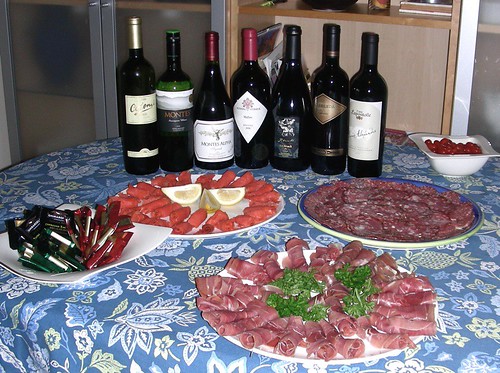
The wines we tasted:
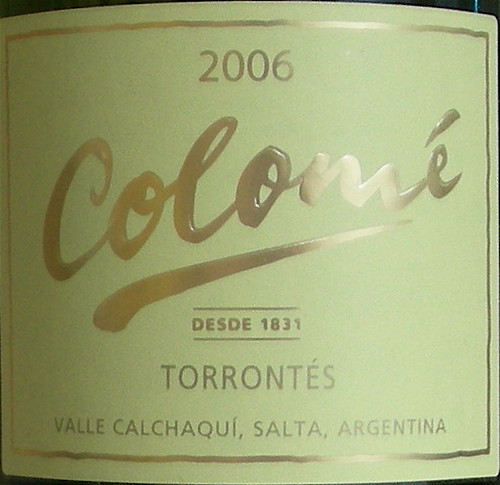 • 2006 Colomé Torrontés Salsa. Torrontés is Argentina's number one white variety although it is practically unknown in other parts of the world. It produces fragrant and fruity wines with crisp acidity and plenty of body. Bodega Colomé is situated at 7500 feet elevation in the Salta wine region near the base of the Andes and is actually the highest altitude winery in the world. Their Torrontès comes from 80-year-old vines farmed using biodynamic principles. My notes: extremely aromatic, a hint of sweetness, medium-bodied, reminded us of a Viognier.
• 2006 Colomé Torrontés Salsa. Torrontés is Argentina's number one white variety although it is practically unknown in other parts of the world. It produces fragrant and fruity wines with crisp acidity and plenty of body. Bodega Colomé is situated at 7500 feet elevation in the Salta wine region near the base of the Andes and is actually the highest altitude winery in the world. Their Torrontès comes from 80-year-old vines farmed using biodynamic principles. My notes: extremely aromatic, a hint of sweetness, medium-bodied, reminded us of a Viognier. 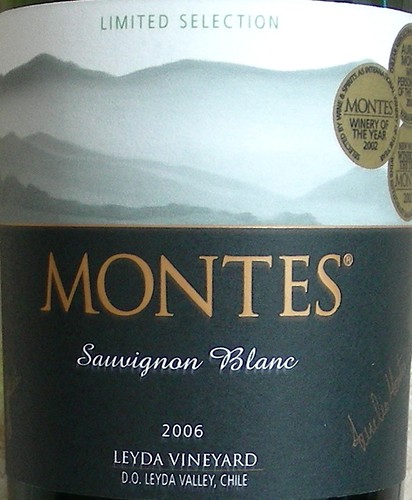 • 2006 Montes Sauvignon Blanc Leyda Vineyard: Viña Montes is a state-of-the-art winery from Chile that was founded in the late 1980s with the mission “to produce the best wines and continue opening markets and bringing the Chilean flag to all the world.”. Every bottle of wine is embossed with a seal that reads “From Chile with pride.” Today, over 90% of the wines from Montes are exported to over 70 different countries throughout the world. This Sauvignon Blanc comes from Leyda Vineyard located north of the Colchagua Valley and slightly cooler thanks due to its proximity to the Pacific Ocean. My notes: very fruity nose, aromas of citrus, crisp, pleasant.
• 2006 Montes Sauvignon Blanc Leyda Vineyard: Viña Montes is a state-of-the-art winery from Chile that was founded in the late 1980s with the mission “to produce the best wines and continue opening markets and bringing the Chilean flag to all the world.”. Every bottle of wine is embossed with a seal that reads “From Chile with pride.” Today, over 90% of the wines from Montes are exported to over 70 different countries throughout the world. This Sauvignon Blanc comes from Leyda Vineyard located north of the Colchagua Valley and slightly cooler thanks due to its proximity to the Pacific Ocean. My notes: very fruity nose, aromas of citrus, crisp, pleasant.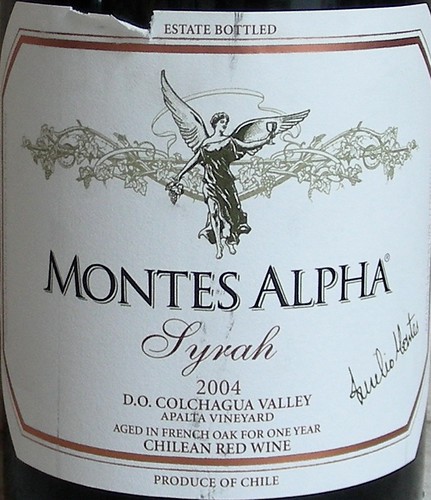 • 2004 Montes Alpha Syrah Apalta Vineyard: The Apalta Vineyard is located in Chile's Colchagua Valley at fairly high elevation, some 40 miles from the coast. The weather is characterized by warm and sunny days and very cool evenings. My notes: purple black color, ripe fruit aromas on the nose, thick, woody, and alcoholic on the palate. Overall, was found bold and for some, unbalanced.
• 2004 Montes Alpha Syrah Apalta Vineyard: The Apalta Vineyard is located in Chile's Colchagua Valley at fairly high elevation, some 40 miles from the coast. The weather is characterized by warm and sunny days and very cool evenings. My notes: purple black color, ripe fruit aromas on the nose, thick, woody, and alcoholic on the palate. Overall, was found bold and for some, unbalanced.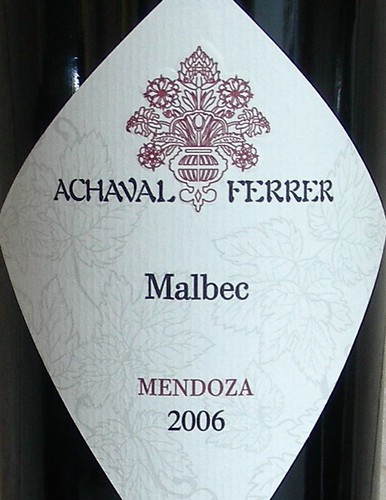 • 2006 Achaval Ferrer Malbec Mendoza: Achaval Ferrer is an Argentinean winery located in the Province of Mendoza, the country's largest wine region. The wine is 100% Malbec, Argentina's great red grape. Malbec is also one of the traditional Bordeaux varietals and the dominant red varietal in the Cahors appellation. Argentinian Malbecs are sometimes considered the best in the world. My notes: dark purple color, black fruit and pepper on the nose, some tannins and acidity on the palate. Nice yet not overly complex.
• 2006 Achaval Ferrer Malbec Mendoza: Achaval Ferrer is an Argentinean winery located in the Province of Mendoza, the country's largest wine region. The wine is 100% Malbec, Argentina's great red grape. Malbec is also one of the traditional Bordeaux varietals and the dominant red varietal in the Cahors appellation. Argentinian Malbecs are sometimes considered the best in the world. My notes: dark purple color, black fruit and pepper on the nose, some tannins and acidity on the palate. Nice yet not overly complex.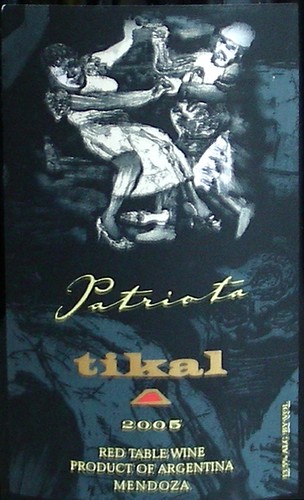 • 2003 Tikal Patriota: from the Mendoza wine region in Argentina, this is a blend of Bonarda and Malbec. Unrelated to the Piedmont grape Bonarda Piemontese, Argentina's Bonarda may be the same grape as Charbono a variety of French origin and imported from California. Bonarda is today the second most widely planted grape variety in Argentina after Malbec. My notes: dark color, rich fruity flavors, well-balanced with some complexity. One of my favorite wines of the evening.
• 2003 Tikal Patriota: from the Mendoza wine region in Argentina, this is a blend of Bonarda and Malbec. Unrelated to the Piedmont grape Bonarda Piemontese, Argentina's Bonarda may be the same grape as Charbono a variety of French origin and imported from California. Bonarda is today the second most widely planted grape variety in Argentina after Malbec. My notes: dark color, rich fruity flavors, well-balanced with some complexity. One of my favorite wines of the evening.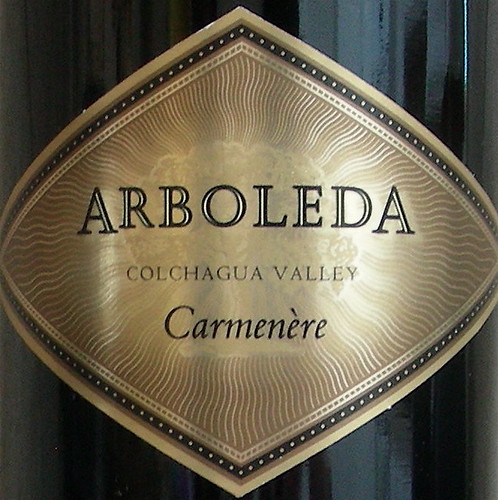 • 2005 Arboleda Carmenère: Also a traditional Bordeaux varietal, Carmenère is currently the rising star of the Chilean wine industry. Because of its susceptibility to mildew and pests, it is rarely used in Bordeaux anymore and as of today, Chile produces the vast majority of Carmenère wines with more than 4,000 hectares cultivated. Arboleda, which in Spanish means grove of trees, is a company founded in 1999 by Robert Mondavi and Eduardo Chadwick of Viña Errázuriz. My notes: deep color, aromas of black fruit and bittersweet dark cocoa, smoky, round mouthfeel, dusty finish. Another favorite of mine.
• 2005 Arboleda Carmenère: Also a traditional Bordeaux varietal, Carmenère is currently the rising star of the Chilean wine industry. Because of its susceptibility to mildew and pests, it is rarely used in Bordeaux anymore and as of today, Chile produces the vast majority of Carmenère wines with more than 4,000 hectares cultivated. Arboleda, which in Spanish means grove of trees, is a company founded in 1999 by Robert Mondavi and Eduardo Chadwick of Viña Errázuriz. My notes: deep color, aromas of black fruit and bittersweet dark cocoa, smoky, round mouthfeel, dusty finish. Another favorite of mine. • 2005 Casa Lapostolle Cabernet Sauvignon Cuvée Alexandre: The Marnier-Lapostolle family, creator of the Grand Marnier liqueur, founded Casa Lapostolle in 1994, purchasing an old wine estate in Chile's Colchagua Valley. The cuvée Alexandre is named after the owner's great-grandfather, Alexandre Marnier, who created Grand Marnier in 1880. It is a blend of 85% Cabernet Sauvignon, 15% Merlot coming from non irrigated 60 year old vines. My notes: deep red color, black berries on the nose, firm on the palate with tannins. Seems too young to be drunk now for my taste, should age a little bit longer.
• 2005 Casa Lapostolle Cabernet Sauvignon Cuvée Alexandre: The Marnier-Lapostolle family, creator of the Grand Marnier liqueur, founded Casa Lapostolle in 1994, purchasing an old wine estate in Chile's Colchagua Valley. The cuvée Alexandre is named after the owner's great-grandfather, Alexandre Marnier, who created Grand Marnier in 1880. It is a blend of 85% Cabernet Sauvignon, 15% Merlot coming from non irrigated 60 year old vines. My notes: deep red color, black berries on the nose, firm on the palate with tannins. Seems too young to be drunk now for my taste, should age a little bit longer.Our next tasting event is our traditional end of the year Champagne tasting. We'll have a great selection of wines, mostly from small Champagne growers so don't miss it!
Previous wine club tastings:
• Tasting Summer Wines from around the Mediterranean Sea
• Guess the wine tasting
• Tasting the wines of Australia and New Zealand
Technorati tags: wine food & drink
4 comments:
It's nice to see reviews about South American wines. South America generaly does not produce the 'Fruit Bombs' as other New World countries. And the terrior is unique in this part of the world. I've been enjoying South American wines for over 12 years now and I must say ... chilean wines are fun to cellar!
Chris Milliken
PengWine www.pengwine.com
Thanks! Yes, I also like Chilean wines, especially those with some Carmenere in the blend
Recently toured Chile and Argentina. Chile, specifically, stood out. Though at times the wines were too dry for my liking.
The Carmenere is an awesome grape!
Favorites include:
Morande
Cousino Macul
Montes Alpha
MontGras
I also like the Veramonte Primus
Post a Comment